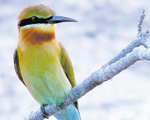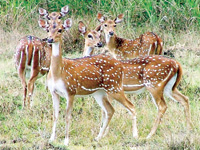|
National
parks of Sri Lanka
Wilpattu National Park
 Wilpattu
National Park is among the oldest and most important of protected
areas in Sri Lanka. Its flora and fauna are representative of the
dry lowland zone. It also contains a number of important cultural
sites. Extension of the park to include the adjacent waters is identified
as a priority. Wilpattu
National Park is among the oldest and most important of protected
areas in Sri Lanka. Its flora and fauna are representative of the
dry lowland zone. It also contains a number of important cultural
sites. Extension of the park to include the adjacent waters is identified
as a priority.
Location
:
The park lies on the northwest coast, 30 km west of Anuradhapura,
and spans the border between North Western Province and North Central
Province. The park is bounded by Moderagam Aru in the south, in
the north the Kala Oya, and in the west Portuguese and Dutch bays
and the open sea. The Wilpattu sanctuary lies inland from the coast.
Access:
The only practical access from Colombo would be via Negombo,
Chilaw and Puttalam. The turn off is at the little hamlet of Thimbiriwewa
at the 28th mile post along the Puttalam Anuradhapura road. The
park office, where one obtains permit and a guide is at Hunuwilagama,
8 km from the turn off.
 Physical
Features : Physical
Features :
The main topographical feature in this park is the concentration
of “villus’ or ‘lakes’ within it. Though
looking like lakes, these “villus” are in flat basin
like depressions on the earth surface containing purely rain water.
Two of these ‘villus’ are saline, due to a characteristic
in the soil. This “villu” feature is peculiar to this
part of the island. The other equally striking feature, though confined
to certain sectors of the park, is copper red, loamy soils extremely
varied. The western sector of the park with deeply forested areas
and thorny bushes is similar to Yala National Park in southern Sri
Lanka.
Wilpattu National Park ranges from sea level to 152m. The area of
Wilpattu National Park is 131,693 ha.
Climate :
Characterized by inter monsoon rains in March and April,
an extensive drought from May until early September and a major
rainy season (northeast monsoon) from September until December.
The average annual temperature is 27.2°C.
History of Establishment :
The area was declared as a sanctuary in 1905 and upgraded
to national park status on 25th February 1938. Wilpattu North Sanctuary
was declared on 7th November 1947. The adjacent areas of Dutch and
Portuguese bays have been proposed as marine extensions to the park,
largely to protect dugong.
Cultural Heritage: -
Much legend and history is associated with the park and
its immediate surroundings. Vijaya landed at Kudrimalai in 543 BC.
Vijaya married Kuveni, the jungle princess, whose palace lies in
ruins at Kali villu. North-east of Maradanmaduwa are Wirandagoda
and Galbendi Niyara where Prince Saliya, son of King Dutugemunu,
is reputed to have lived with his forest bride of low caste, Asoka
Mala, some 2000 years ago.
Kudrimalai,
or Horse Point, was visited by a subject of Emperor Cladius in 47
AD, who was blown off course by monsoon. The local king later sent
his own envoys to Rome during the time of Pliny. The palace of Queen
Alirani, or Aliserrani is reputed to lie buried at Kudrimalai. Pomparippu
is an archaeological site where sealed urns containing human remains
have been found.
These
burials were probably in pre- Vijayan times. There are engraved
stone boundary posts from ancient times at Konwetiya and elsewhere.
Between Palagaturai and Kollankanatte are the remains of an old
harbour. The ruins of an ancient Hindu temple sits on the top of
Kudrimalai Point. Nearby, on the beach lies the grave of a Muslim
saint. The old Catholic church at Pallakandal is visited by several
thousand pilgrims for the annual festival.
In
the eastern part there are remnants of breached tanks left over
from the agricultural systems of ancient Sinhalese civilizations.
Vegetation
:
Three types of vegetation can be distinguished: Littoral
vegetation including salt grass and low scrub immediately adjacent
to the beach; a 5-10 km coastal belt of monsoon scrub of very low
stature; and further inland, monsoon forest with tall trees such
as palu and satin, milia, weera, ebony and wewarana. Some 73% of
the park is dense forest or scrub and the rest is more open habitat.
Fauna:
A total of 31 species of mammals have been recorded but
additional species of Rodentia and Chiroptera are undoubtedly present.
Threatened mammals are elephant, sloth bear, leopard, and water
buffalo. Of the herbivore, spotted deer is the most numerically
abundant species. Dugong occurred in Dutch and Portugal bays adjacent
to the park.
The
“villus” support a variety of resident and migratory
waterfowl, including large breeding populations of painted stork
and open billed stork.
Other wetland species include garganey, pintail, whistling teal
, spoonbill, white ibis, large white egret, cattle egret and purple
heron. Indian darter is abundant in the vicinity of those “villus”
which support a fish fauna.
Common
in the vicinity of “villus’; are white-shafted little
tern, gull billed tern, whiskered tern, great stone-curlew, black
winged stilt and red wattled lap- wing. Among the more noticeable
forest or scrub birds are greater racquet-tailed drongo, Asian paradise
flycatcher, crimson breasted barbet, brown headed barbet, Malabar
pied hornbill, little green bee eater, kingfisher, nightjar, and
fish owl.
Galliformes
are well represented by peafowl and Sri Lanka jungle fowl. Common
raptors include crested serpent eagle, white-bellied sea eagle and
crested hawk eagle.
Among
the most conspicuous reptiles are common monitor, mugger crocodile,
common cobra , rat snake and Indian python. Pond turtle and soft-shelled
turtle are resident in most of the larger permanent “villus”.
Star tortoise is common in grasslands. Termites probably account
for the most significant proportion of the invertebrate biomass.
Termite activity is highest in the scrub-forest, and minimal in
the grassland. |
 Wilpattu
National Park is among the oldest and most important of protected
areas in Sri Lanka. Its flora and fauna are representative of the
dry lowland zone. It also contains a number of important cultural
sites. Extension of the park to include the adjacent waters is identified
as a priority.
Wilpattu
National Park is among the oldest and most important of protected
areas in Sri Lanka. Its flora and fauna are representative of the
dry lowland zone. It also contains a number of important cultural
sites. Extension of the park to include the adjacent waters is identified
as a priority.  Physical
Features :
Physical
Features :